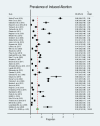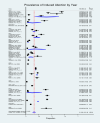Induced abortion in Africa: A systematic review and meta-analysis
- PMID: 38713662
- PMCID: PMC11075855
- DOI: 10.1371/journal.pone.0302824
Induced abortion in Africa: A systematic review and meta-analysis
Abstract
Background: One of the main factors contributing to maternal morbidity and mortality is induced abortion. The WHO estimates that over 44 million induced abortions take place annually around the world. The majority of these abortions-about 50%-are unsafe, significantly increasing maternal morbidity and contributing to 13% of maternal deaths. Thus, this review aimed to estimate the pooled prevalence of induced abortion and its associated factors in Africa.
Methods: To find literature on the prevalence of induced abortion and its associated factors, a thorough search of the internet databases such as PubMed/MEDLINE, African Journals Online, and Google Scholar was conducted. The data were extracted using a structured method of data collection. Software called STATA 14 was used to do the analysis. funnel plot and Egger regression test were used to evaluate potential publication bias. I2 statistics and Cochrane's Q were used to measure the heterogeneity at a p-value < 0.05.
Results: 976 studies were found through a thorough search of electronic databases. Finally, 46 full-text abstract papers were included in this study. The estimated pooled prevalence of induced abortion was 16% (95% CI: 13%-19%). According to the sub-group analysis, most studies were conducted in Ethiopia, and the pooled prevalence was 19% (95% CI: 10%-30%). Similarly, the subgroup analysis by year of study showed that the prevalence of induced abortion was 39% (95% CI: 17%-64%) among studies conducted in 2019.
Conclusion: The results of this study thus imply that the pooled prevalence of induced abortion is higher than that of earlier studies that were published in some nations. the data from this study are needed to support reproductive and adolescent health programmers and policymakers and to formulate recommendations for future clinical practice and guidelines.
Copyright: © 2024 Haile et al. This is an open access article distributed under the terms of the Creative Commons Attribution License, which permits unrestricted use, distribution, and reproduction in any medium, provided the original author and source are credited.
Conflict of interest statement
The authors have declared that no competing interests exist.
Figures









Similar articles
-
Epidemiology of second trimester induced abortion in Ethiopia: a systematic review and meta-analysis.Front Glob Womens Health. 2025 Apr 28;6:1452114. doi: 10.3389/fgwh.2025.1452114. eCollection 2025. Front Glob Womens Health. 2025. PMID: 40357003 Free PMC article.
-
Health care providers`attitude and associated factors to safe abortion in Ethiopia, 2023: A systematic review and meta-analysis.PLoS One. 2024 Sep 17;19(9):e0308419. doi: 10.1371/journal.pone.0308419. eCollection 2024. PLoS One. 2024. PMID: 39288144 Free PMC article.
-
Client satisfaction with abortion care service and its associated factors among women in Ethiopia: a systematic review and meta-analysis.BMC Womens Health. 2024 May 14;24(1):287. doi: 10.1186/s12905-024-03139-3. BMC Womens Health. 2024. PMID: 38745273 Free PMC article.
-
Unsafe abortion and associated factors among reproductive aged women in Sub-Saharan Africa: a protocol for a systematic review and meta-analysis.Syst Rev. 2018 Aug 25;7(1):130. doi: 10.1186/s13643-018-0775-9. Syst Rev. 2018. PMID: 30144826 Free PMC article.
-
Post-abortion family planning use, method preference, and its determinant factors in Eastern Africa: a systematic review and meta-analysis.Syst Rev. 2021 Jun 9;10(1):172. doi: 10.1186/s13643-021-01731-4. Syst Rev. 2021. PMID: 34108044 Free PMC article.
Cited by
-
Epidemiology of second trimester induced abortion in Ethiopia: a systematic review and meta-analysis.Front Glob Womens Health. 2025 Apr 28;6:1452114. doi: 10.3389/fgwh.2025.1452114. eCollection 2025. Front Glob Womens Health. 2025. PMID: 40357003 Free PMC article.
-
Prevalence and determinants of abortion among married women of reproductive age in rural and urban areas of the Southeastern Zone of Tigray, Ethiopia, 2024 a postwar study.BMC Public Health. 2025 Jun 5;25(1):2108. doi: 10.1186/s12889-025-23334-7. BMC Public Health. 2025. PMID: 40474145 Free PMC article.
-
Women's experiences and outcomes of abortion care in sub-Saharan countries: A mixed methods systematic review protocol.PLoS One. 2025 Jan 31;20(1):e0318488. doi: 10.1371/journal.pone.0318488. eCollection 2025. PLoS One. 2025. PMID: 39888867 Free PMC article.
References
-
- World Health Organization(WHO), Abortion care guideline. Geneva: World Health Organization; 2022. Licence: CC BY-NC-SA 3.0 IGO. 2022.
-
- WHO, Unsafe abortion: global and regional estimates of incidence of unsafe abortion and associated mortality in 2008. 2011: World Health Organization.
Publication types
MeSH terms
LinkOut - more resources
Full Text Sources
Medical

